Trek FX+ 1S Review | Legacy Meets Affordable Lifestyle
This mid-weight city commuter has a fun and easy ride, lots of useful integrated tech for those who want to use it, and a simplified experience for those who don’t.
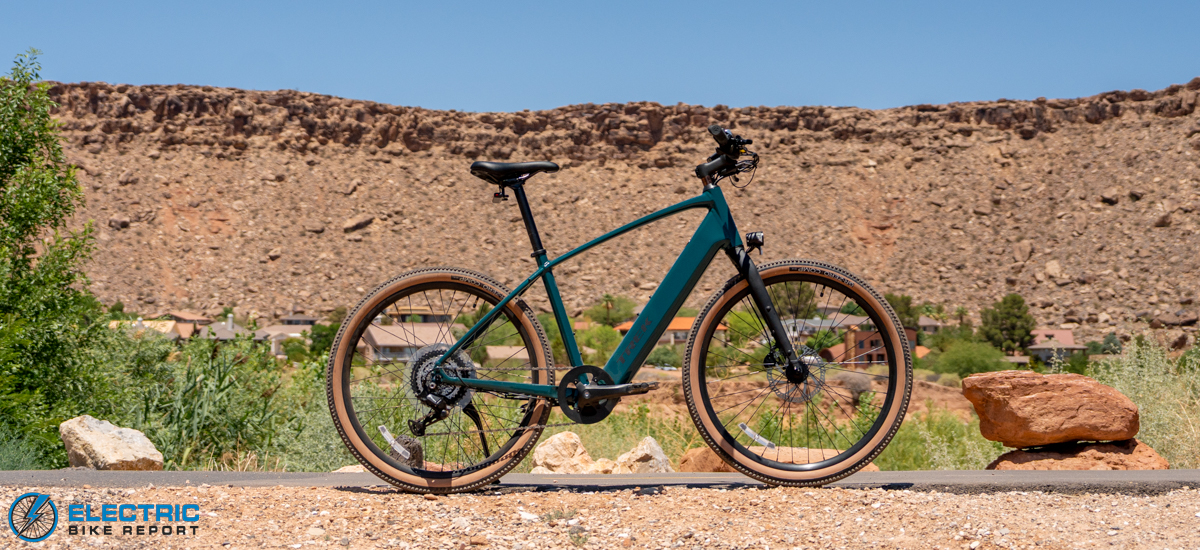
The Trek FX+ 1S is a weird bike.
Not because of funny looks or strange behaviors; as lightweight city e-bikes go, the FX+ 1 looks and feels the part. Instead, the bike is unusual due to a single feature that may not immediately stand out when comparing it to similarly equipped models from other brands.
Unlike previous e-bikes from Trek, which were limited to pedal-assist only, the FX+1S (like its somewhat slower sibling, the FX+ 1) comes equipped with a throttle.
Here at Electric Bike Report, we’ve long espoused the virtues of throttles. Whether of the half-twist or thumb variety, they allow riders an easy way to get moving. They also offer the opportunity to take a break from pedaling—or simply relax and enjoy the ride while the motor does all the hard work.
Like similar global bike companies, Trek built its foundation on decades of analog bike production. While it embraced adding batteries and electric motors to its bikes, the company encouraged the traditional experience of active pedaling by previously producing only Class 1 and 3 e-bikes, despite the increasing popularity of throttle-equipped Class 2s.
Thus, the FX+ 1S marks a turning point—but the throttle wasn’t the only uncommon feature we found and appreciated on the bike. It’s decked out with a powerful 500W motor, an uncommonly large battery, and even a tail light with brake lights and integrated turn signals.
Based on our previous experiences with other Trek e-bikes in the FX+, Allant+, Marlin+, and Verve+ lines, we anticipated that the FX+ 1S would be well-constructed. We also expected it would be engineered for comfort, user-friendliness, and responsiveness. We were not disappointed.
We put the bike through our series of standardized Speed, Range, Brake, and Hill Tests to measure its performance against similar city and urban e-bikes we’ve tested. See our full review below to discover how it compares!
Class 3 (pedal assist to 28 mph)
 Pros
Pros- The FX+ 1S is responsive, speedy, and easy to pedal! This version of the bike can cruise at speeds of up to 28 mph with adaptive torque-based pedal assist and customizable power levels.
- The Trek Central app is a supremely functional addition to the ride. It can provide turn-by-turn navigation, tune the motor, track ride data, and more.
- It boasts crisp, precise handling, along with an uncommon level of comfort and stability (for this style of bike), thanks to its wide 50mm gravel tires.
- It performed well in our range test, yielding some of the longest results we’ve recorded for a city bike. We met and slightly exceeded Trek’s advertised 50-mile range.
- The bike features many small details that make a big impact. In addition to the throttle, it comes with an intuitive and fast EasyMag charger, a color display, and integrated turn signals.
- The bike’s price point of around $2k makes it one of Trek’s most affordable e-bikes (outside the Electra line) and is on par with models from many smaller lifestyle e-bike companies.
- Trek offers four frame sizes to provide a tailored and comfortable fit for a wide range of riders.
- Tech enthusiasts can tailor the ride and expand the bike’s functionality, but the FX+ 1S is minimalist enough to be simple and user-friendly for those who don’t want to use the app.
 Cons
Cons- As is relatively common with city e-bikes, the FX+ 1S’s battery cannot be removed for charging; the whole bike needs to be brought inside.
- We occasionally encountered connection issues that prevented the app from pairing; restarting the bike and app solved the problem.
- Battery: 520Wh, integrated in the down tube
- Display: LCD display
- Motor: Hub drive motor, 60 Nm, 500W, 36H, black
- Headlight: Herrmans MR8, 180 lumen, 60 lux, LED headlight
- Taillights:Sate-Lite M-15 with turn signal and brake light function
- Pedal Assist: 3 Assist levels (Eco, Mid, High)
- Claimed Range: Up to 50 miles
- Throttle:Thumb throttle
- App:Trek Central
- UL Certification:UL 2849 Certified
- Claimed weight: 48.73 lbs
- Tested Weight: 49.9 lbs
- Rider height range: 5’1” – 6’6”
- Total payload capacity: 300 pounds (including bicycle, rider, and cargo)
- Brakes:Rush BH-286 hydraulic disc, 180mm rotor
- Fenders:Not Included
- Fork:Alloy, internal brake routing, fender mounts, rack mounts, ThruSkew 5mm bolt-on skewer
- Frame: Alpha Gold Aluminum, internal cable routing, internal battery, rack & fender mounts, flat mount disc brake, kickstand mount, 144.5mm OLD hub motor spacing
- Drivetrain:8-Speed, Shimano ESSA U2000 derailleur, 40T steel chainring, Shimano HG400 11-45T cassette
- Grips: Bontrager XR Endurance Comp, lock-on
- Saddle: Bontrager Sport
- Handlebar: Bontrager alloy, 31.8mm, 15mm rise, 690mm width (S, M), 720mm width (L, XL)
- Kickstand: Adjustable length alloy kickstand
- Pedals: Bontrager City pedals
- Tires: Bontrager GR0 Comp, wire bead, 60 tpi, 650x50mm
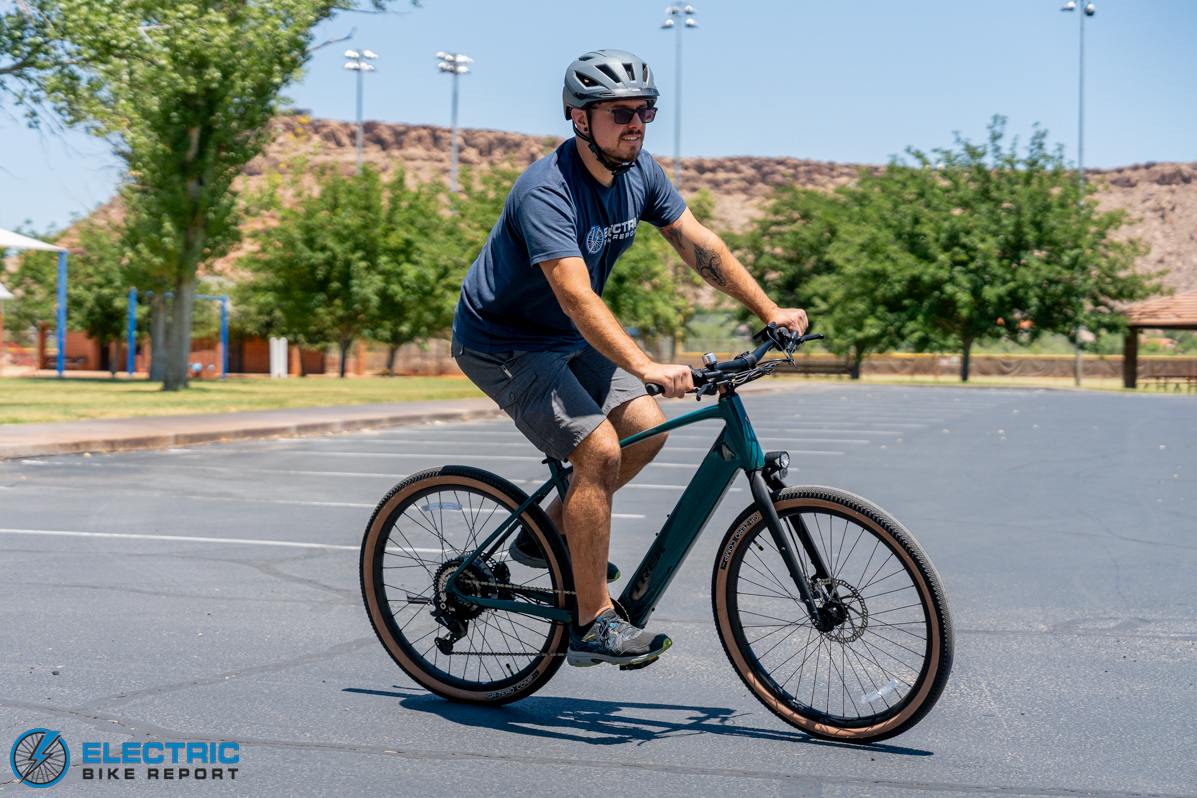
In contrast with the standard FX+ 1, which is limited to 20 mph, the FX+ 1S can reach Class 3 speeds up to 28 mph.
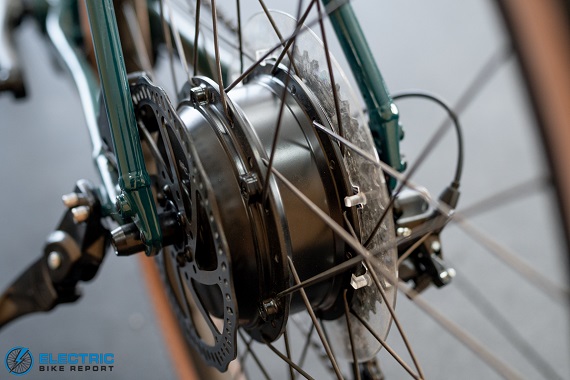
A 500W rear-hub motor dishes out power liberally and responsively, making for a fun and active (though not strenuous) ride.
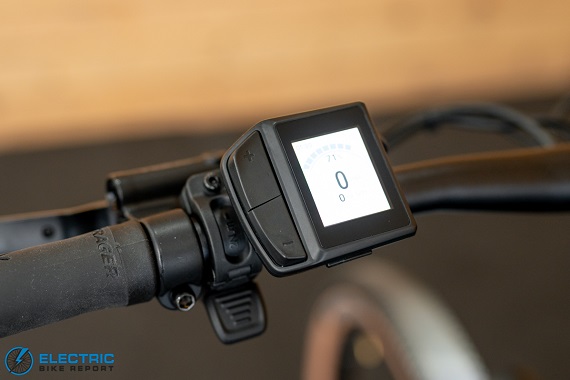
The bike’s throttle lever and display/control panel are mounted on the left handlebar next to the grips.
Trek FX+ 1S Review: Speed Test
Here in southern Utah, we are fortunate to have an excellent network of paved shared-use paths locally. I performed our Speed Test on a flat segment of this system by pedaling in each of the FX+ 1S’s three assist settings (Eco, Mid, and High). I also tested the bike’s throttle to gauge its responsiveness and determine how quickly it could reach 20 mph.
The graph above shows my results, which created a relatively linear pattern, reflecting consistent increases in speed and power. Based on how the bike felt during the test, I wasn’t surprised to see this shape to the graph; the three modes felt well-balanced and intuitive while riding.
I was impressed with the bike’s programming, but also by the nearly silent nature of its motor. I also liked that even the lowest assist level provided a significant amount of power to make pedaling active, easy, and enjoyable. I actually spent most of my time on the bike in Eco mode, which isn’t something I can say about most bikes I’ve tested!
I thoroughly enjoyed riding at faster speeds using the Mid and High modes, but I thought Eco felt great for casual cruising. The Mid setting felt ideal for getting around faster when I was in a hurry, while the High level seemed best for reaching top speed and pedaling up steep hills. Due to the relatively high baseline of power, however, I didn’t encounter too many hills that I needed to use High to pedal over.
In my throttle acceleration test, the bike started gradually and then picked up speed steadily. I could tell that there was significant power behind the throttle, even though it ramped up approachably; it felt safe and controlled, but also plenty capable.
Overall, I feel that the bike performed great in this test; the FX+ 1S is off to a fantastic start!
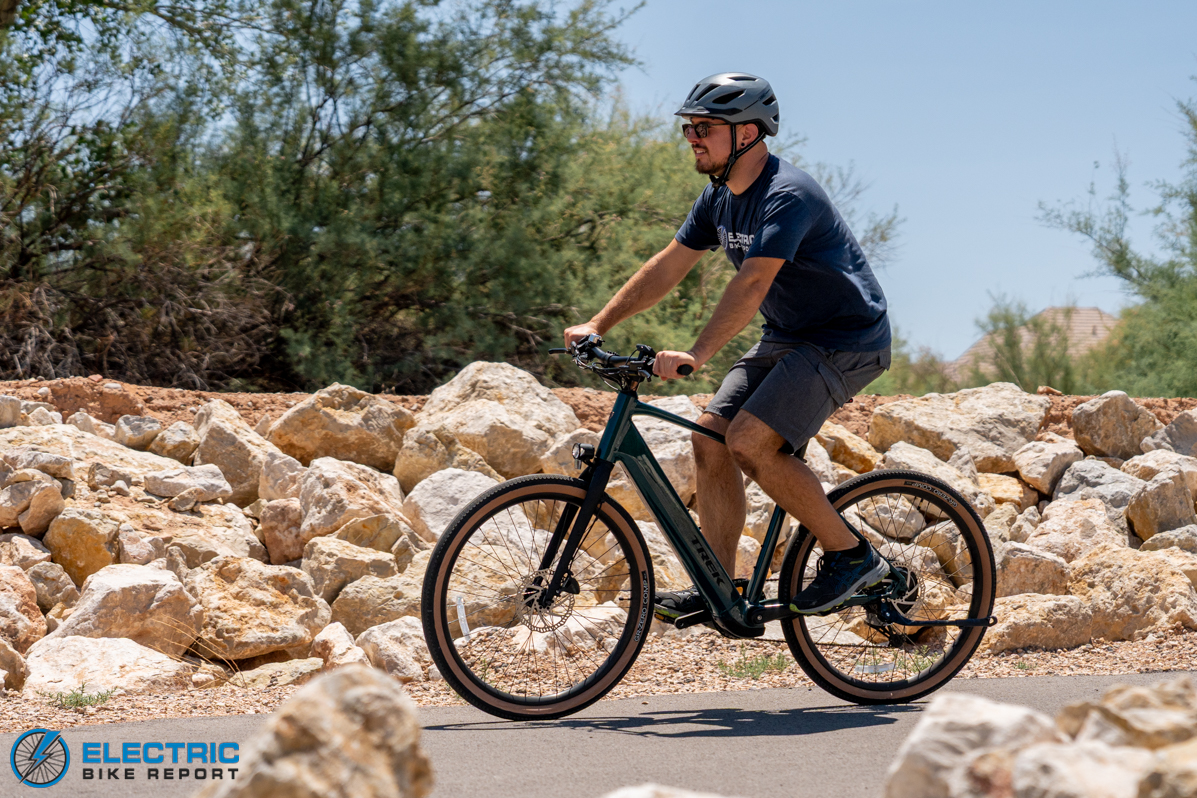
We think the FX+ 1S would be great for leisure, exercise, commuting, light off-road adventuring, and more!
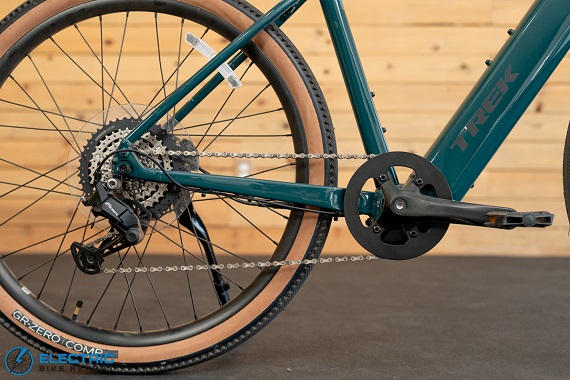
An 8-speed drivetrain provides a great range of gearing options for riding at high speeds and pedaling uphill.
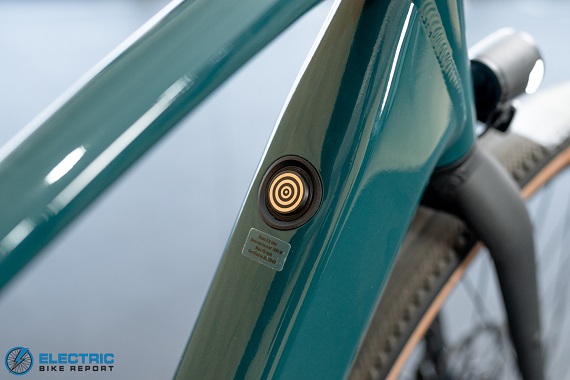
The magnetic attachment point makes connecting the EasyMag charger fast and struggle-free.
Trek FX+ 1S Review: Range Test
The graphic above includes an explanation of our Range Test(s); we measured the FX+ 1S’s range using this method and achieved distances of 33.4 and 51.9 miles from a single charge.
Both of these results are above average when compared to similar bikes we’ve tested. A pool of comparable models averaged 22.1 and 47.1 miles using their highest and lowest assist levels, so there was more difference between the FX+1’s high-power test results and the average than there was with its low-power test results.
On the high end, the main difference between this bike and the others used for comparison seemed to be battery capacity. The FX+ 1S carries a 520-watt-hour (Wh) battery, while the pool of similar models had batteries with an average of 345 Wh.
When performing our test, we adhered to the 20 mph speed limit on our local shared-use paths, so the bike wasn’t burning through as much power as it would have had we been pedaling faster. For this reason, the FX+ used roughly the same number of watt-hours per mile (Wh/m) as similar bikes (approximately 15.6 Wh/m), so its higher-capacity battery allowed it to ride longer.
On the low end, the difference between our Range Test results was smaller because of the above-average power output in the Trek’s lowest assist level. The higher power output made this bike somewhat less efficient than average (it used 10 Wh/m compared to the average of 7.3 Wh/m), but again, its large battery still gave it a slight edge.
A potential range of between 33 and 52 miles is advantageous for several reasons:
First, Trek advertises a range of up to 50 miles, which our results support.
Second, most riders we interact with have commutes of 20 miles or less, so we’d expect most users in that category to get at least a couple of round trips from one charge.
Third, riders using this bike for leisure should be able to cruise on many shorter trips before needing to recharge.
Speaking of charging, Trek included a cool and user-friendly EasyMag charger with the FX+ 1S. It has a magnetic lead that connects quickly and effortlessly to a port on the down tube, making it by far one of the easiest chargers I’ve tested. I liked that it stuck right on without the need to fiddle with it to get it to line up properly.
The charger is also made to be convenient; it can mount to a wall, and it features a highly visible light ring with a circle of bars that illuminate as the battery charges. I found it very easy to see where the charge level was by a single glance, instead of having to turn the bike on to see its percentage or bar-based readout.
Additionally, the charger puts out 2.7 amps, so it can power up the battery relatively quickly —it takes only about 4 hours to go from fully depleted to full.
There are some other uncommon battery-related features that we’ll discuss in more detail in the Ride Quality section below when we delve into the app, but I do have one downside to mention that relates to charging. While not uncommon among city e-bikes, the fact that the FX+1S’s battery is fully internal means that it can’t be removed for charging. As such, owners will need to bring the entire bike inside for charging.
Trek FX+ 1S Review: Hill Test
Once again, the process used for our Hill Test is explained in the graphic above with the FX+ 1S’s results. At the time of writing, comparison with other bikes is relatively difficult; we’re still in the process of building our dataset at the Devil’s Backbone since we switched our test location from the previous hill at Hell Hole Trail.
Still, we can examine some details about the FX+1’s performance. Historically, e-bikes in the city/urban category have typically had some of the slower results, but as I mentioned in the Speed Test section above, this one has a bit more pep in its step than many others.
Despite its extended nature, the bike completed both portions of our test; Justin finished the throttle portion in 2:18, while maintaining an average speed of 13.4 mph. His High Mode pedal test results were noticeably faster, with a time of 2:11 at 14.1 mph.
Again, we don’t yet have a huge number of bikes to compare to, but those that we have tested at our new location—which represent a variety of e-bike styles, not just those in the city category—averaged 2:13 in their pedal tests.
The FX+ 1S is relatively average in comparison to the broad pool of bikes we’ve tested, but it’s important to consider that other e-bike styles tend to be more powerful than city bikes. As such, the FX+ is more powerful than most bikes in its category.
It’s also worth noting that we’ve only seen a handful of e-bikes in the city/urban category equipped with throttles, and at least so far, the others we’ve tested at the Devil’s Backbone were unable to complete the test. That puts the FX+ 1S in a great place, showing that while it’s not outrageously fast when climbing, its throttle does have enough power to be effective.
As I mentioned in the intro, users can tune the bike’s motor output through the Trek Central app. By default, neither the power nor the sensitivity settings for the High assist level are set to maximum. I tested the FX+1 at our secondary location, called Pilot Hill, to see how much of an effect there would be if I cranked up both settings to their highest levels.
With the default settings, my results were 1:11 at 16 mph. My second test with the highest output yielded results of 1:10 and 16.2 mph, so there were only minimal differences when going by the numbers. I did, however, notice slightly easier pedaling after I made the adjustments.
The bottom line here is that the FX+ 1S is one of the best climbers we’ve tested in the city category. It has a manageable weight while still being up to the challenge of dealing with big hills, making it relatively unique in its category. In many cases, it should give riders the choice between throttling and pedaling uphill.
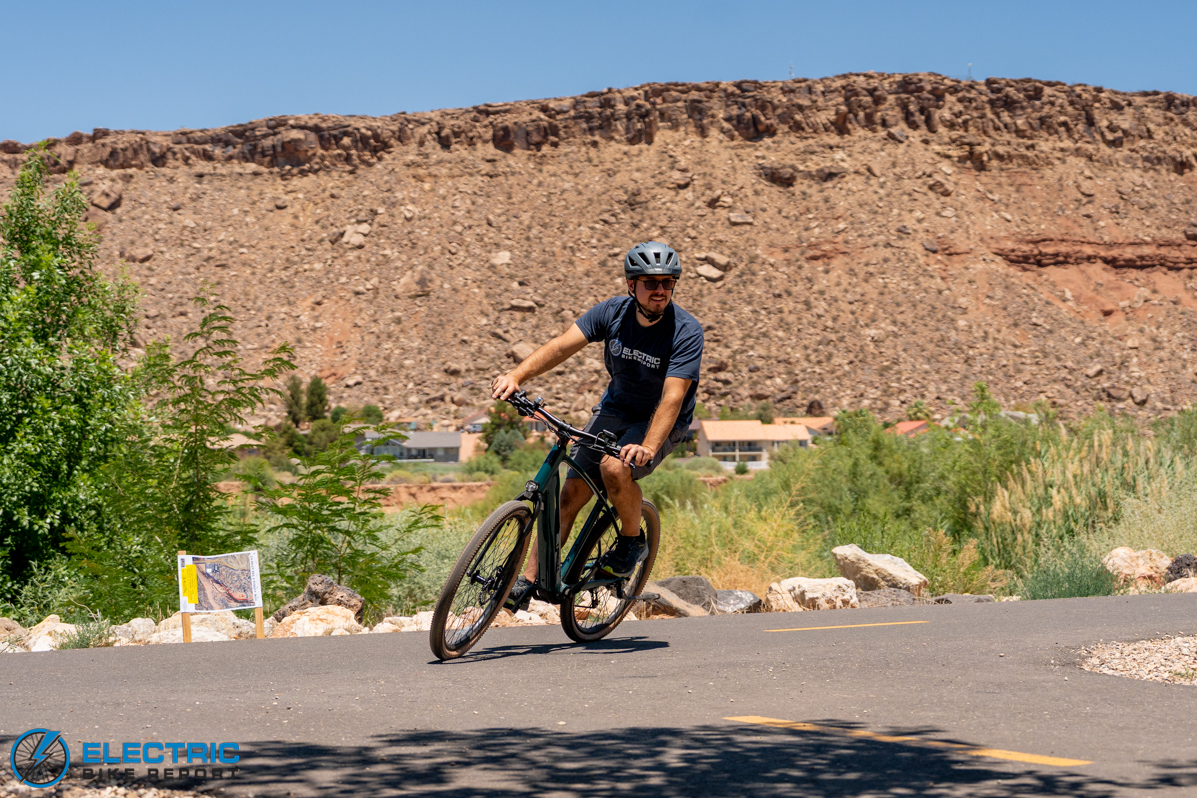
The FX+ 1S has a sporty, but not too aggressive, riding position that we found quite comfortable.
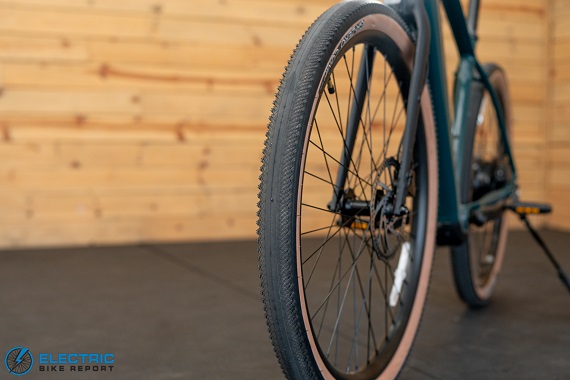
We liked the versatility and ride cushioning granted by the tires; they’re great for paved and unpaved surfaces.
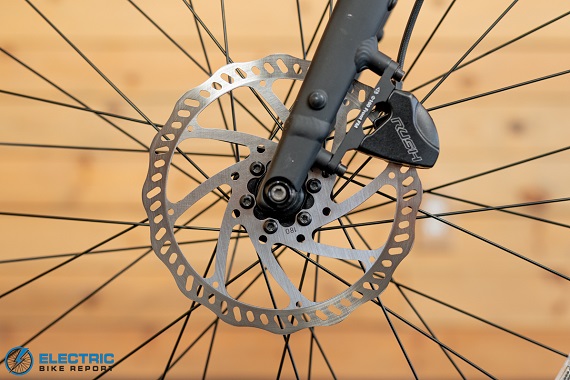
The Rush hydraulic disc brakes performed very well in our testing.
Trek FX+ 1S Review: Brake Test

The FX+ 1S is equipped with a 2-piston hydraulic disc brake system from Rush with 180mm front and rear rotors. We tested its performance in our Brake Test using the process described above. The bike’s final score, an average of its three test results, was 20’10”.
As with our previous test sections, I compared the Trek’s result with a handful of similar city e-bikes we’ve tested; those bikes averaged 23’1”, making the FX+1S’s result over two feet shorter than average.
We’re not as familiar with Rush brake systems as we are with others, but as evidenced by the bike’s score, they did well. The fact that they use standard mineral oil means that they are easy to service, and I thought their performance felt great during my time on the FX+ 1S.
Most similar city bikes we’ve tested came with smaller 160mm rotors, but the FX+ was on the heavier side in comparison (still quite manageable by e-bike standards), so I was happy to see that it had larger 180mm rotors to compensate.
The wide tires seemed to aid its braking performance, as well. I noticed that they seemed to skid fairly easily, which was not unexpected, considering the band of smooth tread down the center. Their uncommon 50mm width, however, helped to provide better traction and braking stability than the narrower tires found on most similar bikes we’ve tested.
Once again, everything checks out here. We consider the FX+ 1S to be well-equipped with safe and effective brakes!
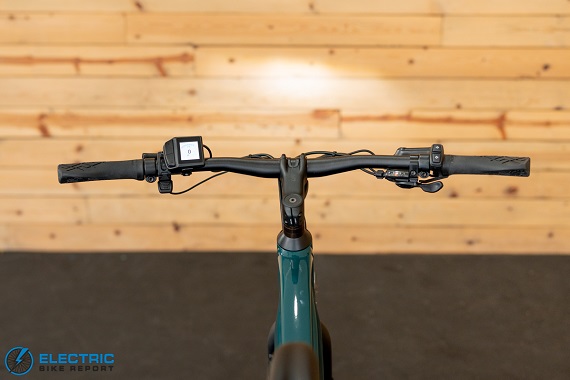
The 720mm handlebars on our test bike provided good steering control and plenty of room for the bike’s controls.
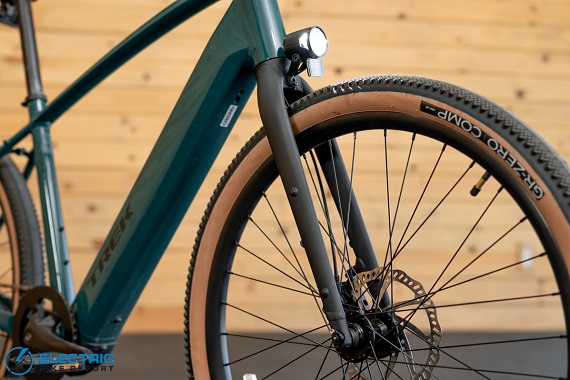
A rigid fork contributes to the bike’s crisp cornering and predictable handling.
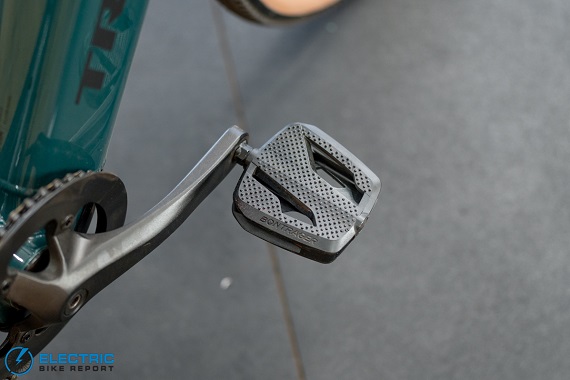
While the bike includes plastic platform pedals, Trek offers a variety of grippier replacements.

The FX+ 1S includes a slim but well-padded saddle.
Trek FX+ 1S Review: Ride Quality
Ride Quality is a complex topic that incorporates many elements of a bike’s feel and user experience.
Beginning with sizing, the FX+ 1 is available in two frame styles: a high-step and mid-step design. The mid-step option comes in three frame sizes, with a recommended height range of 5’1” to 6’1”. The high-step we tested is appropriate for a wider range of riders, with four sizes that accommodate those from 5’1” to 6’6”.
I specifically rode the large high-step frame, which is designed for riders between 5’9” and 6’1”. At 5’11”, I am right in the center of its target height range. As I’ve come to expect from global legacy brands like Trek, I found the bike’s proportions to be ideally suited for me; its 6.5” of saddle height provided proper leg extension, while its reach felt balanced between sportiness and comfort.
Like many of the best city and urban e-bikes, the FX+ 1S has a forward-leaning (but not too aggressive) riding position. With a rigid fork, wide handlebars, and some of the rider’s weight distributed to the handlebars, I found its handling to be appropriately crisp and its steering to be expectedly precise; these factors make city e-bikes one of my favorite styles.
I liked the saddle, the handlebars, and the grips, but I do want to mention that you’ll probably want to plan on upgrading the pedals. The bike comes with plastic pedals that work fine, but they don’t have the best grip. Trek offers a slew of options to choose from (and a guide to help you sort through them), so most riders should be able to find something that fits their style.
As I referenced in the Brake Test section above, its tires added a welcome layer of stability to the ride. The Bontrager GR-Zero tires have a relatively square cross-section with a central smooth band for efficient rolling on paved surfaces and knobby shoulders for dirt and gravel use.
I tested the bike on all three surfaces—even some chunky gravel that felt slippery on many other e-bikes. The FX+ 1S’s tires handled all areas extremely well, maintaining great stability and traction while also adding an appreciable amount of cushion.
The bike’s motor engagement is also superb, with smooth power delivery and quick adaptation to changes in pedal pressure. Its motor is remarkably quiet; in most cases, I heard the normal clicking of the rear wheel hub more than the motor itself.
Out of the box, the FX+ 1S is relatively simple; its cockpit is filled with its display/control panel, throttle lever, and shifter. The color display itself was functional and readable, while its buttons were large and unmissable. Overall, I found the layout practical and straightforward, with all controls within easy reach.
The FX+ 1S doesn’t have many bells and whistles—aside from the integrated lights and turn signals, which I have to say I was pleased to see for the sake of safety. There are a ton of optional accessories that can be added to expand the bike’s use cases, but without getting into Trek’s app, the bike is completely suitable for those who prefer a low-tech experience.
The app, however, makes the bike well-suited for tech junkies. It’s extremely feature-rich, and perhaps one of the most useful I’ve encountered. In addition to customizing the motor output, users can track ride data (manually or automatically), access turn-by-turn navigation, receive tire pressure recommendations, and even control the battery and its lifespan.
There are four unique battery features:
- The Charge Alert function will send your phone a notification when the battery reaches your desired charge level.
- The Extended Life Mode reduces range and the maximum charge level slightly to extend the number of charge cycles and reduce wear.
- The Optimized Charging feature makes trickle charging standard for those who keep their bike plugged in.
- Finally, the Long Term Storage mode will place the battery in a “sleep” mode to preserve its charge.
Another feature I loved was what Trek calls a “range cloud.” When looking at a GPS map (which can be downloaded to show your location when off-grid), the app shows two boundaries that represent the bike’s range: a thin red line that marks the point at which the battery reaches 50%, and a thick red outline that represents the distance you can ride before reaching 0%.
The app generally worked quite well, but I occasionally encountered pairing issues when I opened the app before turning on the bike. Restarting both the app and the bike solved the problem, but hopefully, Trek’s development team can work on improving the connectivity.
Otherwise, the FX+ 1S’s ride quality was and is excellent! We found it to be comfortable, well-sized, responsive, stable, and high-tech while also being approachable.
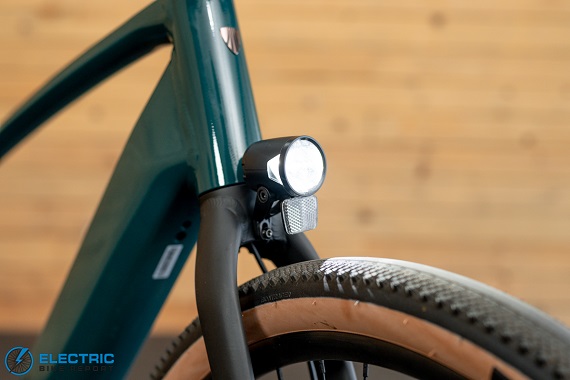
A small LED headlight is mounted to the fork to provide low-light visibility.
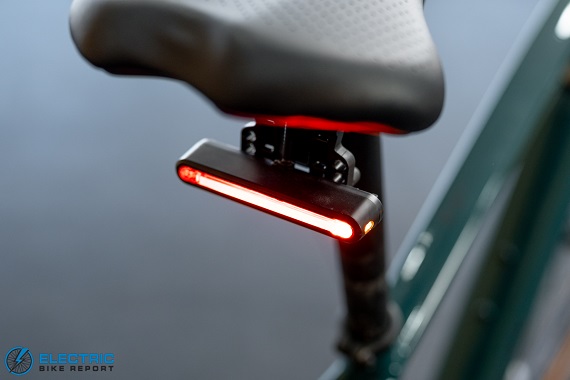
The bike’s taillight and turn signals are mounted beneath the saddle.
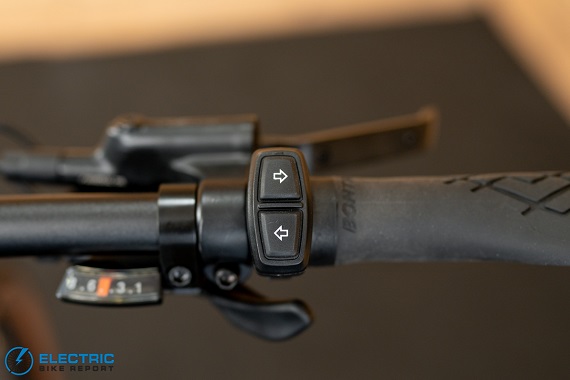
A module on the right handlebar includes two buttons to activate the integrated turn signals.
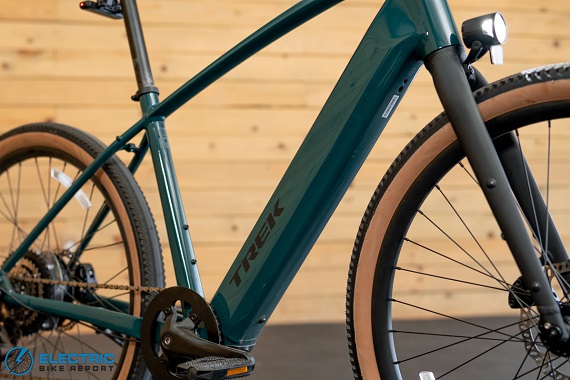
The bike’s 520-Wh battery is sealed in the bike’s down tube, though it can be accessed for service.
Trek FX+ 1S Review: Summary / Where to Buy
Due to its throttle and its relatively high power output when using pedal assist, the FX+ 1S is a different kind of e-bike for a legacy brand like Trek. It’s clearly designed for mass appeal, and I believe it succeeds in the areas required to achieve that goal. However, I don’t think the brand compromised so much that it has lost touch with its roots as a Trek e-bike.
First, because of its sizing and geometry, the fit felt nicely dialed in; the FX+ 1S’s ride felt comfortable and ergonomic.
Second, features like the MagSafe charger and the Trek Central app felt like areas where the bike stepped up to the premium tier—I believe consumers will highly appreciate such benefits at this price point.
Third, even with the motor producing a substantial amount of power, I found that the ride remained engaging, making it suitable for those who want to get in a good workout or simply experience smooth, responsive, and helpful (but not overpowering) pedal assist.
The FX+ 1s scored well all around in our performance tests. It checks all the boxes we typically look for, including an intuitively programmed pedal assist system and a user-friendly interface. It also has uncommonly good climbing power for its style, along with great range and excellent braking performance.
We identified only a handful of points of critique, which are primarily things to be aware of ahead of time instead of things to be corrected. Most notably, when charging the bike, the battery’s sealed nature makes charging somewhat more difficult than with removable batteries. Second, we encountered some occasional pairing issues when using the Trek Central app, but we were able to resolve them by restarting both devices.
Otherwise, this bike proved to be impressively comfortable, fun, and versatile, while also being one of the most affordable e-bikes in Trek’s lineup. Most obviously, the FX+ 1S could be a great option for those looking for a sporty leisure bike, exercise bike, or commuter.
Additionally, its manageable weight makes it relatively easy to load onto a vehicle rack. Its optional tech features make it equally friendly for those who want something minimalistic and easy, or those who like diving into the details of motor tuning and navigation. The bike’s gravel tires make it suitable for riding on a variety of surfaces.
And finally, since this model can reach 28 miles per hour, it’s an ideal choice for those who want to get around a bit faster than the standard FX+ 1 can go.
Happy Riding! Make sure to let us know if you have any questions or if you think we left anything out in this review of the Trek FX+ 1 down in our comments section.




Thank you for providing this review. I have decided this is the e bike for me.
That’s great! Let us know how you like it once you get a few rides in!
The Trek FX+ 1S review was very informative, as always, and it’s good to see a throttle emerge on a major producer’s bike in the U.S. My only disappointment was that you didn’t test it on your 12% incline hill, since that’s the same grade I ride to get to my house, and I’m worried whether the 60Nm motor can make it. Any idea how it might do based on the tests you ran on the 8% hill?
Thanks!
Out of any e-bike of this style we’ve tested with a throttle, this one would probably have the best chance on throttle power, but it’s hard to say for sure. You may need to supplement throttle power with pedaling to reach the top, but even if that is necessary, you shouldn’t need to pedal terribly hard.